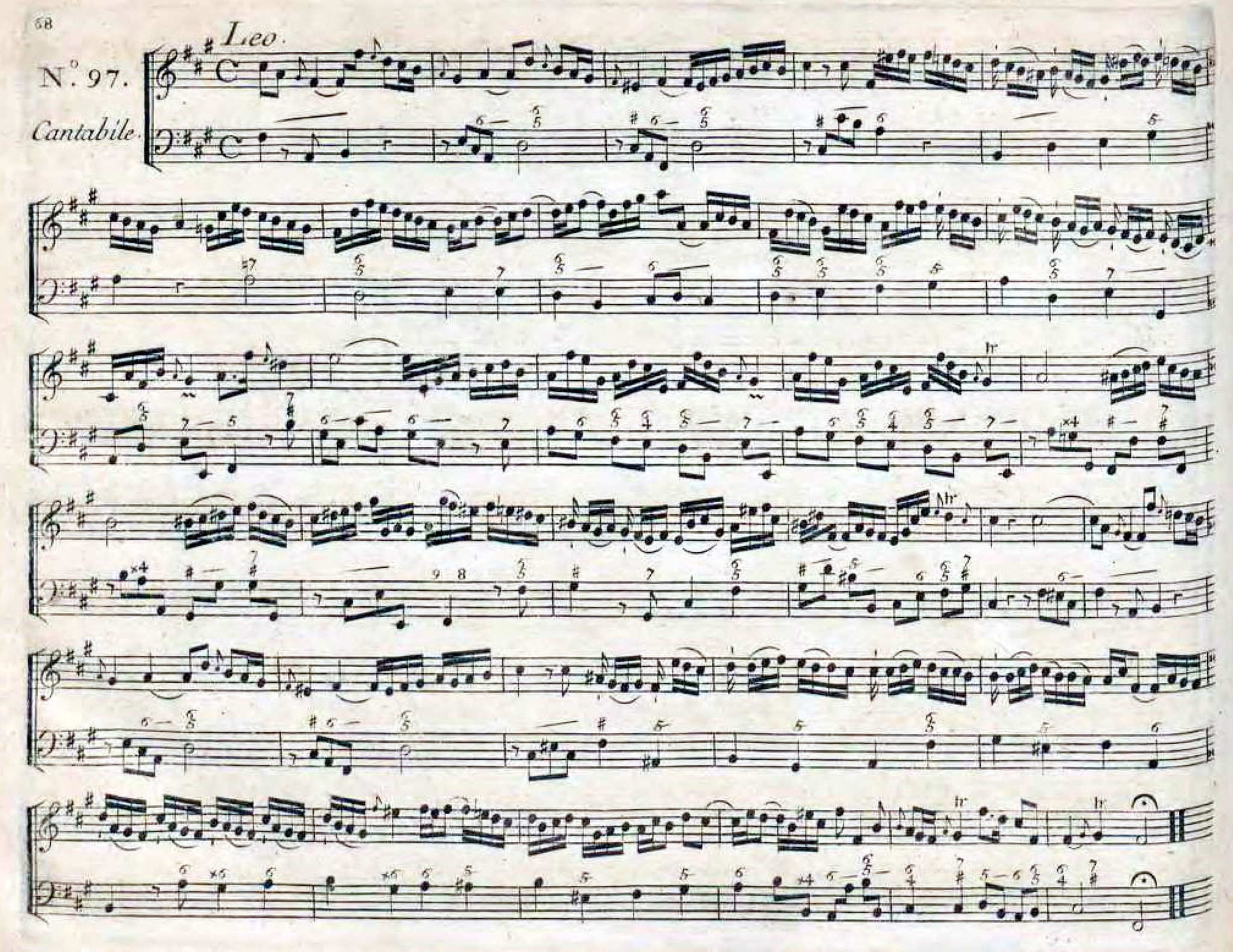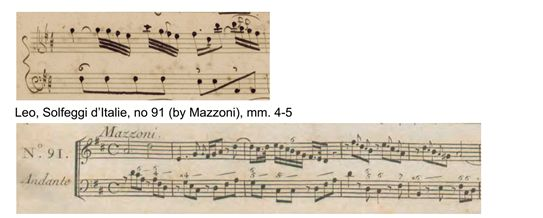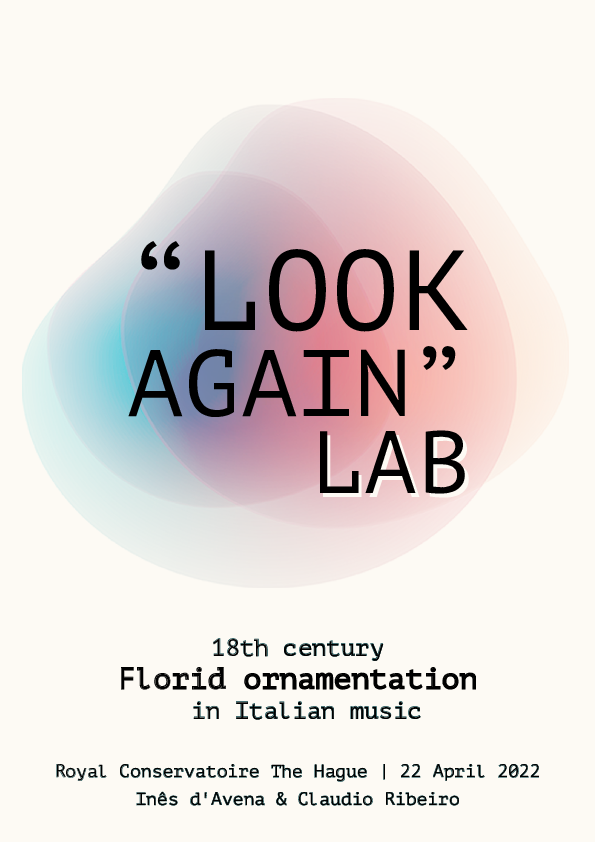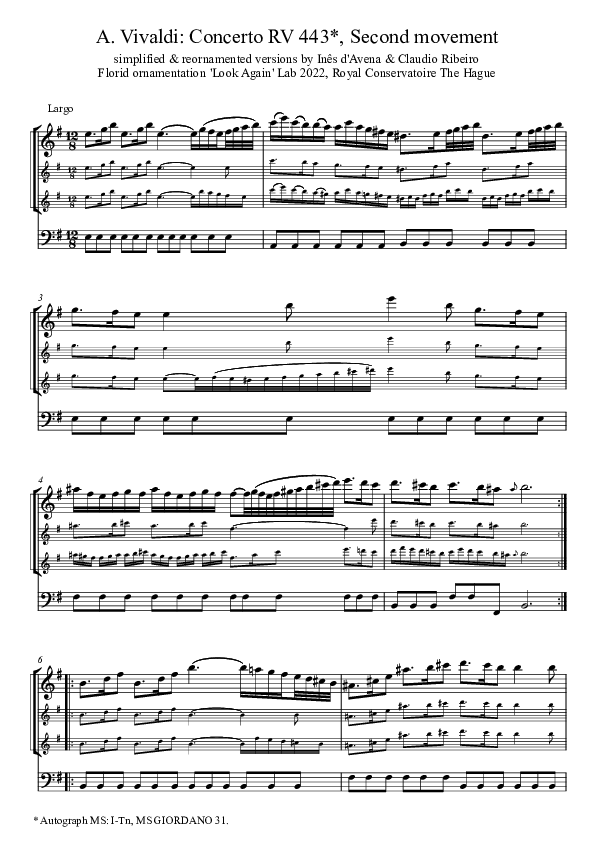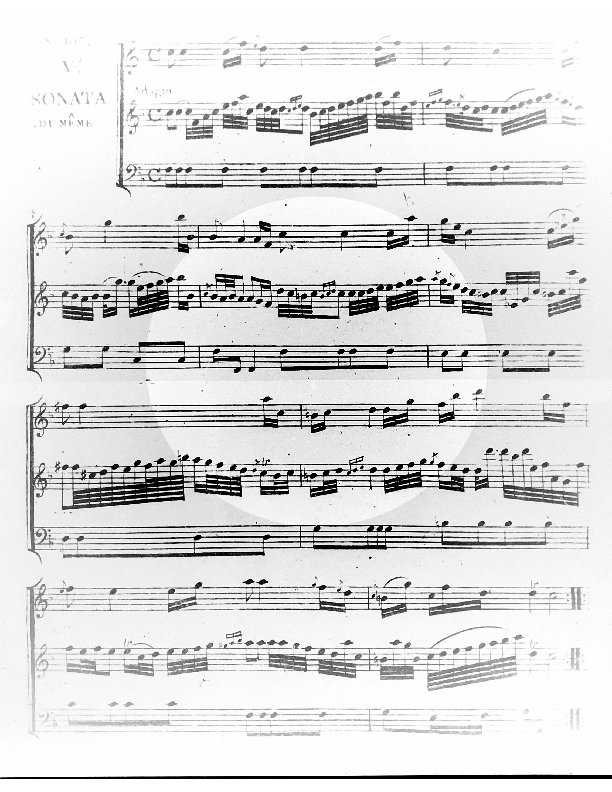Florid ornamentation
The most famous example of florid ornamentation is probably found in the edition published by Estienne Roger (Amsterdam, 1710) of Arcangelo Corelli’s op. 5 (originally published in Rome in 1700). In our current Early Music performance practice it has become so ubiquitous that this very personal ornamentation style (however popular it became, already in the 18th century) is often applied to any Italian(ate) work, and used for repertoire spanning almost the entire duration of the 18th century. However, as with any other aspect of performance practice, the ornamentation style was (slightly) different for every period, region, composer and probably every performer.
In this case study we explored other examples of florid ornamentation: a solfeggio by Leonardo Leo, ornaments written by Vivaldi for RV 443, an ornamented Adagio by Carlo Zuccari, and an ornamented Adagio by Pietro Nardini. Corelli, however useful, was not included because we wanted to expand our vocabulary and get to know other styles of ornamentation in Italian 18th-century music.
DEFINITION
What do we mean by florid ornamentation? The combination of several types of ornaments: grace notes, passaggi (or passing, running notes, which includes in itself diminution), rhythmic alteration and, to a certain extent, the rewriting of the piece.
1. PREPARATION: A FIRST APPROACH TO THE SOURCES
First we worked on a few sources ourselves, also to be able to prepare the workshop we would do later with the students. We started by making a selection of ornamentation sources and of slow movements to ornament based on those sources.
1.1 Leo: first try
We selected a few slow movements by Leo and some of his solfeggi from different sources, a few of which are shown below. (click to open)
We first played his pieces and ornamented them using our current knowledge of Italian florid ornamentation - so we basically did what we would do normally. We then played the solfeggi we had selected and played once again the same pieces by Leo, trying to ornament them in his style. These were our observations, before and after studying the solfeggi:
before
Inês: difficult to ornament repeated notes, especially because they lose the emphasis repeated notes usually have. It was also difficult to immediately ornament a piece I didn’t know beforehand, so sight-read while adding florid ornamentation (and not just grace notes).
Claudio: used a lot of triplets and triplet-formulas from the middle of the 18th century because he knew those better and finds them easy to apply, and because he often sees this kind of ornamentation written in pieces with a similar style.
after
Inês: found it extremely difficult to let go of her own ‘original’ (previous) ornaments, which kept coming back when trying to use the inspiration from the solfeggi. Would a more systematic, analytical approach to reading the solfeggi have helped?
Claudio: remembered some elements from the solfeggi and tried to apply them, but had the feeling that his source of ideas had dried up. The cadenza formula from one solfeggio was very clear but didn’t fit well the piece he was playing (different harmony/starting note).
Since he was transposing all the time and trying to line up r.h. and l.h., most of his concentration went to that and not to learning the ornaments.
Some reflections after this first approach
- Reading the ornamentation source once and trying to immediately apply it to other music did not work well, especially with unfamiliar music. First the ornamentation source needs to become 'second nature'.
- A more systematic, analytical approach to the ornamentation sources would be helpful to avoid defaulting to our own ornamentation patterns.
- Reading from familiar clefs in comfortable keys would help to concentrate on the material itself.
1.2 Leo: second try
A week later we did a more thorough study of Leo's solfeggi: we analyzed them before playing, looking for ornamentation patterns, then we simplified the melody, and finally we studied how the simple melody and the ornaments related.
2. KC WORKSHOP APRIL 22, 2022
To extend the experimentation to more people we organized a 'Look Again Lab' on 18th century florid ornamentation in Italian music. All KC Early Music students (and interested teachers) were welcome to join. Twelve participants signed-up: eleven students (3 harpsichords, 2 recorders, 1 saxophone, 2 traversos, 3 violins) and 1 teacher (recorder/oboe). There were three 'no-show' and two extra listeners (1 teacher, 1 alumnus).
During the two hours we had, we read through selected examples of florid ornamentation in slow movements (solfeggi by Leo, Adagios by Zuccari, etc.), discussed them together (pointing out what we had found in our analysis), and played through them; all participants had been asked to bring a slow movement from any Italian work from the 1st half of the 18th century, so we then tried out suitable ornaments on the spot, based on the examples we had read.
For the workshop, we selected three sources representative of different ornamentation styles (written in different decades), to explore with the students:
Workshop structure
- a participant played the ornamented source
- the group worked on simplifying the melody, a participant played it
- the group identified patterns in the ornamented source
- a participant played his/her own ornaments on the simplified melody, based on the ornamented source; the group offered suggestions to this re-ornamentation based on the ornamented source
- a participant first played another piece with their own ornaments; then with ornaments based on the ornamented source, and the group offered suggestions
Some reflections after the workshop
-
When we worked on the simple melody, instead of asking one person to play it, we should have had everyone play it
-
At the start, we should have shown more examples, because, with only three, each example became another type of ‘Corelli’
-
It should have been longer, at least three hours long
Since we also wanted to have the reflections of the participants, we send out a short questionnaire.
Participant 1 (violin): Yes
Participant 2 (traverso): They were!
Participant 3 (recorder/oboe): yes
Participant 4 (traverso): yes
Participant 5 (saxophone): Yes,I've played vivaldi .
Participant 6 (violin): Yes, very much so!
Participant 7 (harpsichord): It was, not for my solo repertoire, but for BC and working with others.
Participant 1 (violin): I really liked getting ornamentation ideas from the sources, but I found myself trying to dive into the complexity of the ornamentation too soon. This made me feel a little overwhelmed by all the things that weren't working.
Participant 2 (traverso): To me it felt slightly strange, because I had a typical (probably Corelli-influenced) Adagio to work with, and the different ornaments from the sources didn’t really seem to fit that piece, because their basic style already seemed very different to me from what I was working on. Leo’s solfeggio with its triplety ornaments felt much more galant, and I could see myself using those in for instance a Telemann or Graun light third movement for instance, but not in the kind of Adagio I was working with. Vivaldi’s ornaments for his slow movement are in that sense also quite peculiar, since the 12/8 feeling of the Siciliana is such a constraining metre that a more Corellian ornamentation would definitely not have fitted the movement, but their metric strictness didn’t seem appropriate to my Adagio either. Lastly, Zuccari’s ornaments were the easiest to adapt to my piece, but they also seemed rather similar to non-Italian sources like Telemann’s Sonate Metodiche, so I’d hesitate to add them to a piece with a very simple bass line, because I feel the result might be a bit stiff because of their metric character.
Participant 3 (recorder/oboe): I didn't really do that publicly. But I had brought a Vivaldi sonata and thought that some of the ornaments might have been difficult to apply. But that's the adventure of course :)
Participant 4 (traverso): Even if i didn't do it in the workshop i found the suggestion very interesting. It is a nice tool for inspiration when writing ornaments.
Participant 5 (saxophone): It's useful for me. If I play it with thinking about ornament style of composer ,I need to use my brain more. After that I could stok new option of ornaments . Also it makes music simple and natural .
Participant 6 (violin): It was educational and inspiring; I will continue developing these techniques in my practice.
Participant 7 (harpsichord): Better understanding of the structural notes, and better differentiation between them and the "extra" ornamentation.
Participant 1 (violin): Yes! I really liked getting inspiration directly from the music, and not just written out ornamentation guides.
Participant 2 (traverso): I did find the methodology helpful but would for a future occasion perhaps limit at least the metre of the chosen pieces so the ornaments can be applied in a more obvious way.
Participant 3 (recorder/oboe): It was! More time would have been great of course :), and other than that I felt like focus on a little passage and going into depth for a bit of the session would have been a nice addition.
Participant 4 (traverso): Yes, it gave me an idea about how to do it by myself.
Participant 5 (saxophone): Yes, Especially when we play the skeleton of melody,I recoginize meaning of ornament and preferness of composer more.
Participant 6 (violin): Yes, even though some of the example pieces were a bit too complex.
Participant 7 (harpsichord): Yes, I often do similar things on my own repertoire as well.
3. A SECOND APPROACH TO THE SOURCES
After the workshop we worked ourselves on ornamenting in the style of Vivaldi, and later on Nardini.
First, we played the second movement of RV 443 (1720-1724, I-Tn, MS Giordano 31), analyzed it one more time and, after simplifying the flute part, created a different ornamented version of the piece. This is the result:
We then took a similar piece by Vivaldi (also a Siciliana-like movement) to work on, the second movement of the concerto RV 428, ‘Il Gardelino’ (published by Le Cène in Amsterdam, c. 1728).
We played it once and Inês ornamented it the way she usually would, then we analyzed RV 443 one more time and applied its style of ornamentation to RV 428. This is a video of the before and after:
The last source we worked on was the ornamented Adagio of a violin sonata by Pietro Nardini (sonata V). This collection, published in Paris c. 1801, was composed probably around 1765/66 and published for the first time in Venice (date unknown).
To apply this style of ornamentation, we chose a slow movement of a keyboard sonata by Baldassare Galuppi (Sonata op. 1 no. 3), first published by Walsh in London in 1756.
Claudio first played the movement ornamenting it the way he would normally do, then we worked on an ornamented version using the patterns from Nardini’s piece. It proved to be very difficult to apply the ornamentation style of a piece in 4/4 on a piece in 3/4, so we ended up ornamenting only the first section. This is the before and after:
Some reflections after this second approach
Inês observed that in RV 428, after studying Vivaldi’s ornaments, she made ornaments in places where she normally doesn’t. Claudio, on the other hand, had as a starting point to look for different ornaments for the places where he would normally ornament.
It was important for us to realize that it is not a matter of substitution of ornaments already in our vocabulary but of enriching our vocabulary with other ideas, from different sources, in order to be able to apply these other ideas whenever suitable. An understanding of what suits what style becomes second nature by playing more and more examples, but also by analysing how the ornamentation relates to the simpler structure of the melody.



